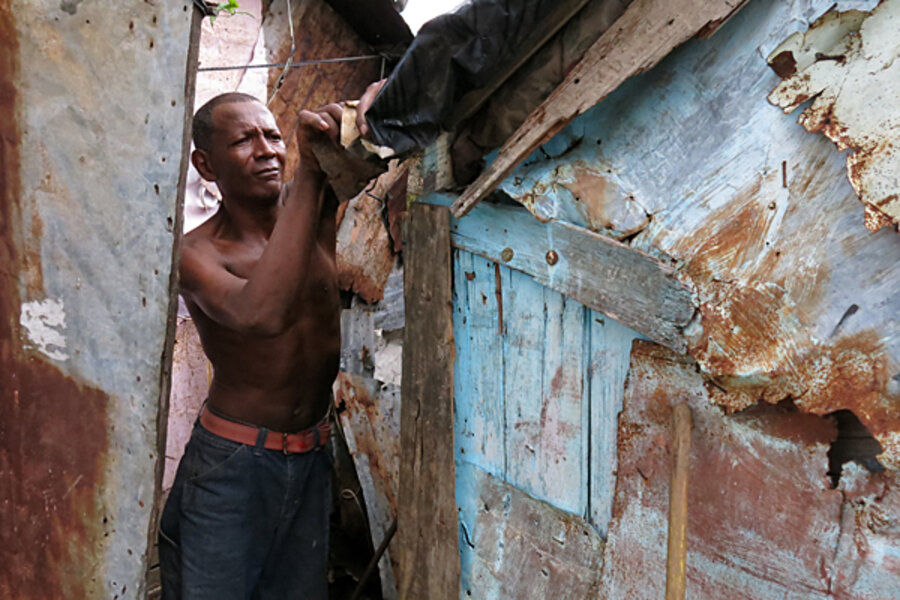Tropical Storm Chantal threatens Dominican Republic, Haiti
Loading...
| San Juan, Puerto Rico
Tropical Storm Chantal roared south of Puerto Rico early Wednesday on a path that will see it pass over the Dominican Republic and Haiti, where authorities warned of possible landslides and heavy flooding.
Chantal was becoming disorganized and a hurricane watch was discontinued for the Dominican Republic's southern coast, according to the National Hurricane Center in Miami, Florida. However, atropical storm warning was in effect for the Dominican Republic, Haiti, Puerto Rico, Turks and Caicos, and the southeastern Bahamas.
Officials in the Dominican Republic, where Chantal was expected to make landfall Wednesday afternoon, urged those living in low-lying areas to evacuate, but few paid heed.
"We're sure nothing is going to happen," said Geovanny Batista, leader of an impoverished community in the capital of Santo Domingo built largely of wood, cardboard and zinc.
"We can't just go and leave behind our belongings," he said. "Thieves will come and take them."
Officials in Haiti, which is forecast to feel the brunt of ChantalWednesday evening, encountered similar resistance despite repeated radio warnings.
Street vendor Marc St. Juste said he was unaware a storm was coming, but upon learning the news, he decided to remain outside a bit, if only to sell a few more snow cones in downtown Port-au-Prince, Haiti's congested capital.
"I'm going to go home as soon as possible," St. Juste said as he pushed his rickety wooden cart topped with frozen ice and colorful syrups. "But I'm still going to stay out to make as many sales as possible."
Both Haiti and the Dominican Republic are vulnerable to flooding and landslides from storms, but widespread deforestation and ramshackle housing in Haiti mean even moderate rains pose a significant threat.
Haiti is already in the middle of its rainy season, with 279,000 people still living in grim settlements that popped up in the capital and elsewhere after the devastating 2010 earthquake.
Up to 10 inches (25 centimeters) of rain could fall in parts of the island of Hispaniola, which the Dominican Republic and Haiti share, the hurricane center said.
The storm was located about 235 miles (380 kilometers) south of San Juan, Puerto Rico around 2 a.m. EDT (0600 GMT) Wednesday, according to the hurricane center. The storm maximum sustained winds had decreased to 50 mph (80 kph), and it was moving west at 30 mph (48 kph).
Meteorologists with AccuWeather warned that the U.S. territory of Puerto Rico could be hard hit, given that some 13 inches (33 centimeters) of rain already have fallen in the capital of San Juan since June, nearly twice the normal rainfall for that period.
"Much of the landscape is primed for excessive runoff and flooding," AccuWeather said.
At least 17 roads will be closed as a preventive measure in the southern mountainous town of Yauco, where some 30 percent of the population lives under zinc roofs, Mayor Abel Nazario told the AP.
"When it rains a lot, a portion of the mountain comes down," he said. "That's always a concern."
Meanwhile, in the popular southwest tourist town of Cabo Rojo, crews cleared branches and debris to prepare for heavy rainfall, said Milton Llitera, the town's emergency management director.
"When this floods, it doesn't forgive," he told the AP.
A tropical storm watch was in effect for the U.S. Virgin Islands, Vieques and Culebra and central Bahamas.
Chantal had raced through the eastern Caribbean early Tuesday, with officials in Dominica reporting that heavy winds ripped off the roofs of several homes. No injuries were reported there or anywhere else in the region.
Chantal also forced Carnival Cruise Lines to change the itineraries of two of its ships, the Carnival Liberty and Carnival Victory, spokesman Vance Gulliksen said.
___
Coto reported from San Juan, Puerto Rico and Lopez from Santo Domingo, Dominican Republic. Associated Press writers Trenton Daniel in Port-au-Prince, Haiti; Carlisle Jno Baptiste in Roseau, Dominica; and David McFadden in Kingston, Jamaica contributed to this report.





